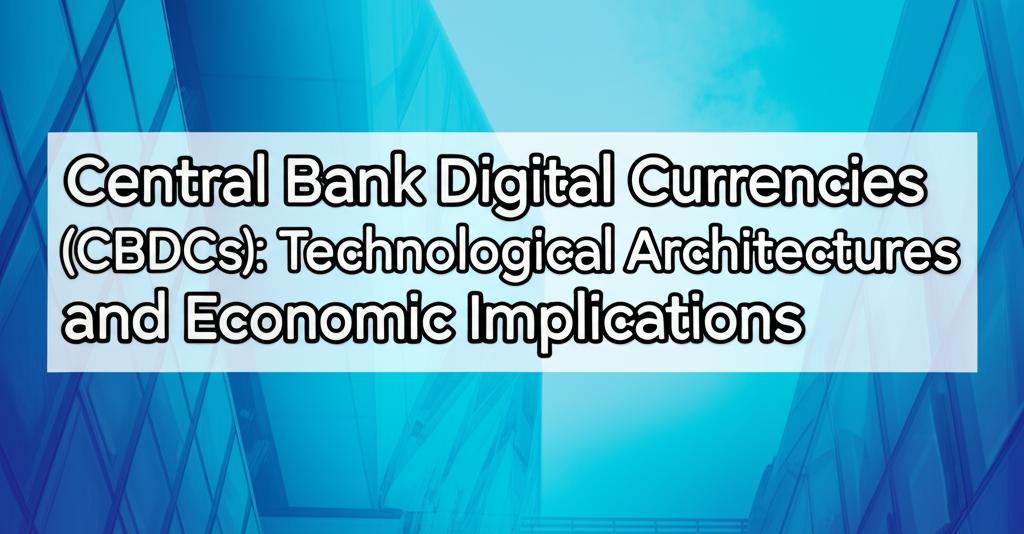Central bank digital currencies (CBDCs) represent a digital form of a country's fiat currency, issued and backed by the nation's central bank. Unlike cryptocurrencies, which are typically decentralized and issued by private entities, CBDCs are centralized and carry the full faith and credit of the issuing monetary authority. Globally, interest in CBDCs has surged, with over 130 countries, representing 98% of global GDP, actively exploring, developing, piloting, or launching them as of early 2025. This exploration is driven by the increasing digitization of payments and finance, and the desire of central banks to maintain monetary sovereignty and provide a safe, public digital payment option.
Technological ArchitecturesThe design and implementation of a CBDC involve critical choices regarding its underlying technology and operational structure. Key architectural considerations include:
- Infrastructure Technology: CBDCs can be built on conventional centralized databases or employ Distributed Ledger Technology (DLT), such as blockchain.
Centralized Systems: Often utilize traditional database technology, offering potentially higher transaction throughput and lower technical complexity, with direct control residing firmly with the central bank.
DLT-Based Systems: Offer potential benefits like enhanced resilience and programmability ("smart contracts"). However, they often involve complex consensus mechanisms that can limit transaction speed and scalability, making them potentially more suitable for wholesale or indirect retail models rather than large-scale direct retail systems currently. Many experimental projects use DLT elements, but often under a form of centralized governance (permissioned ledgers).
- Distribution Model: This defines the operational roles of the central bank versus private sector intermediaries (like commercial banks and payment service providers).
Direct Model: The central bank directly manages all aspects, including opening accounts, processing transactions, and handling customer due diligence (KYC/AML). This offers simplicity but places a significant operational burden on the central bank.
Indirect Model: The central bank issues CBDC to intermediaries, who then manage retail services and user accounts. This resembles the current two-tier banking system and is the model used by nearly all advanced retail CBDC projects currently. The central bank may only see wholesale balances.
Hybrid Model: A combination where individuals might hold claims directly on the central bank, but payment services are managed by private intermediaries. This seeks to balance resilience and central bank liability with private sector innovation.
- Access Method: How users hold and transact with the CBDC.
Account-Based: Ownership is tied to identity verification, similar to traditional bank accounts.
* Token-Based: Value is embedded in a digital token, a "bearer instrument" similar to physical cash, potentially offering greater anonymity but posing challenges for recovering lost funds or tracking illicit activity.
Central banks are actively experimenting with various ledger technologies and architectures, weighing factors like performance, resilience, security, privacy implications, and environmental impact to determine the optimal fit for their specific policy goals. Cybersecurity and the development of robust regulatory frameworks are paramount considerations in any design.
Economic ImplicationsThe introduction of a CBDC could have profound economic effects, bringing both potential benefits and significant challenges:
Potential Benefits:- Enhanced Payment Efficiency: CBDCs promise faster, cheaper, and more efficient payment systems, both domestically and cross-border, potentially enabling real-time settlements 24/7. This could significantly reduce remittance costs.
- Increased Financial Inclusion: By providing easier access to digital payments, potentially even offline, CBDCs could help integrate unbanked and underbanked populations into the formal financial system.
- Fostering Innovation and Competition: A CBDC could serve as a platform for private sector innovation, enabling new payment services and financial products built upon a secure public infrastructure, potentially increasing competition in the payments landscape.
- Strengthening Monetary Policy: Some argue CBDCs could improve the transmission of monetary policy, although the precise effects are still debated.
- Maintaining Monetary Sovereignty: In an era of private digital currencies and potential foreign CBDCs, a domestic CBDC can help maintain the role of central bank money as the anchor of the financial system, ensuring the "singleness of money" (interchangeability at par between public and private money).
- Improved Resilience: A CBDC offers an alternative digital payment system that could function even if private systems face disruptions.
- Combating Illicit Activity: The potential for increased traceability could aid efforts against money laundering and terrorist financing, though this raises privacy concerns.
- Reduced Costs: Potential reduction in costs associated with managing physical cash. Some analyses suggest CBDCs could positively impact central bank seigniorage income through cost savings.
- Bank Disintermediation: A major concern is that readily available, safe CBDCs could lead to large outflows from commercial bank deposits, particularly during times of stress. This could shrink banks' funding base, potentially reducing credit availability and impacting financial stability. The design, especially whether the CBDC bears interest, is crucial here.
- Financial Stability Risks: Large-scale shifts into CBDCs during crises could exacerbate bank runs.
- Privacy Concerns: Finding the right balance between transaction traceability (for security and anti-crime) and user privacy is a fundamental challenge. Design choices heavily influence the degree of anonymity.
- Cybersecurity Threats: As critical infrastructure, CBDC systems would be prime targets for cyberattacks, requiring extremely high levels of security and resilience.
- Implementation Costs and Complexity: Developing, deploying, and maintaining a CBDC system represents a significant technological and financial undertaking for central banks.
- Adoption and Public Trust: Ensuring widespread public acceptance and use requires building trust and demonstrating clear user benefits.
- Regulatory Frameworks: Comprehensive legal and regulatory structures need to be established or adapted to govern CBDCs, covering areas like consumer protection, data privacy, and operational standards.
In conclusion, CBDCs represent a potential evolution of money, driven by technological change and shifting payment habits. While they offer prospects for improving payment systems, financial inclusion, and innovation, they also pose significant risks to financial stability and raise complex questions about privacy and the future role of commercial banks. Central banks worldwide are proceeding cautiously, recognizing that the specific design choices will be critical in determining whether the benefits of a CBDC ultimately outweigh its potential drawbacks.

